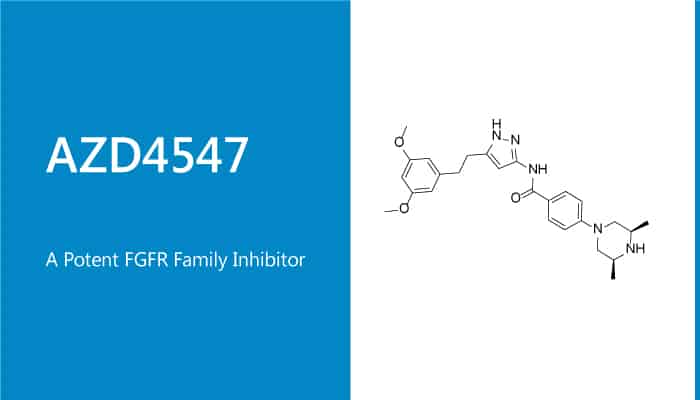Fibroblast growth factors (FGF) and their receptors play important roles in multiple biologic processes, such as tissue repair, hematopoiesis, angiogenesis, and embryonic development.
The FGFR family mainly comprises 4 main members (FGFR1–4). FGFRs and FGFRs FGF ligand binding can result in FGFR dimerization. In addition, receptor autophosphorylation and activation of downstream signaling pathways happen at the same time.
Aside from their essential physiologic roles, FGFs and FGFRs are liable to be oncogenes that drive the proliferation of a significant proportion of human tumors. Until now, the Blockade of FGF/FGFR signaling is an approach for cancer therapy.
In this article, we will introduce a potent and selective FGFR tyrosine kinase inhibitor AZD4547 in vitro and in vivo.

Firstly, in vitro, AZD4547 can inhibit recombinant VEGFR2 (KDR) kinase activity with an IC50 of 24 nM. Additionally, In Sum52-PE, MCF7, and KMS11 cell lines, AZD4547 can potently inhibit autophosphorylation of FGFR1, 2, and 3 tyrosine kinases with IC50 values of 12, 2, and 40 nM, respectively. This compound also displays weaker inhibition of FGFR4 cellular kinase activity (IC50=142 nM).
Moreover, AZD4547 a significantly weaker inhibitory activity in cellular KDR and IGFR ligand-induced phosphorylation (IC50 values of 258 and 828 nM, respectively). When this compares to cellular FGFR1, it less approximately 20- and 70-fold selectivity for KDR and IGFR respectively. Besides, AZD4547 potently inhibits FGFR phosphorylation and downstream signaling affected through FRS2, PLCγ, and MAPK at the cellular level.
In vivo, in female SCID mice bearing KMS11 tumors, those mice are randomized and treated chronically with AZD4547 at a range of well-tolerated doses. AZD4547 with oral administration results in dose-dependent tumor growth inhibition.
AZD4547 at 3 mg/kg gives statistically significant tumor growth inhibition of 53% with a twice-daily administration. Furthermore, doses of 12.5 mg/kg once daily and 6.25 mg/kg twice daily leads to complete tumor stasis. Besides, in the KG1a model, AZD4547 results in 65% tumor growth inhibition when twice treated per day.
In conclusion, AZD4547 is a potent inhibitor of the FGFR family with low IC50s. This compound revels potential in vitro and in vivo.
Reference:
Gavine PR, et al. Cancer Res, 2012, 72(8), 2045-2056.